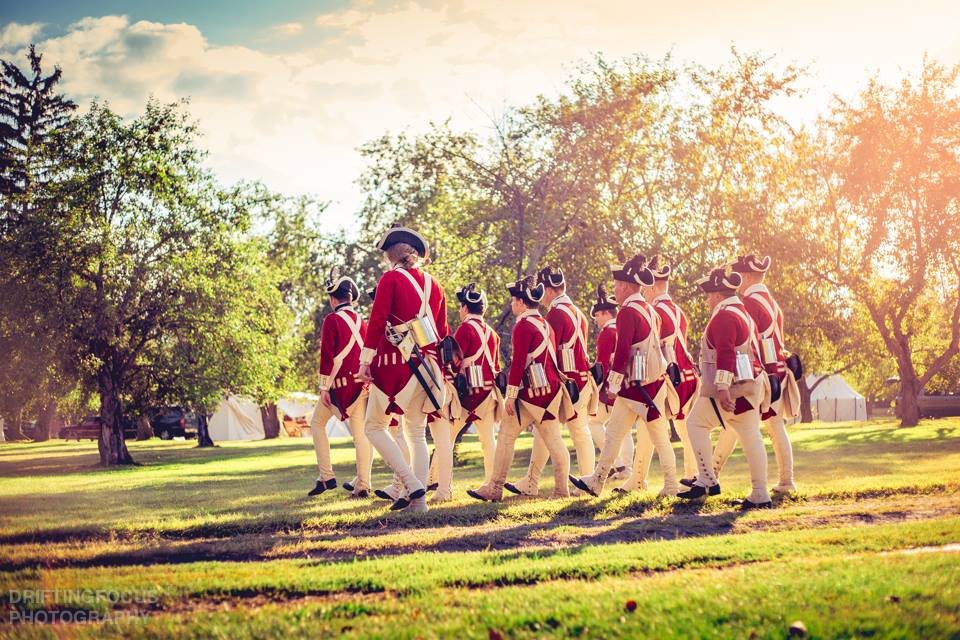
Revisit the best of the blogs from 17th and friends!
Bands of Music in the British Army 1762-1790. Part 3
In the previous two postings, we've looked at what a band was, who were in them, what types of music a band played, and what kind of ceremonies they played at. Perhaps most interesting to those lovers of material culture and military uniforms is what these bandsmen wore.
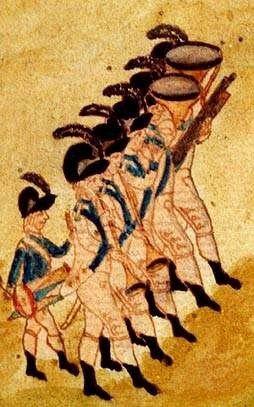
The uniform of a bandsman varied depending on the regiment. These men were not drummers and fifers so the rule of reversed facings does not apply to them. Ultimately, the uniform of the band was left up to the officers paying for them. One way to see what they wore is through deserter ads. This first one comes from our very own 17th:
Deserted from his Majesty’s 17th regiment of foot, quartered in Perth, John Humphreys musician, aged twenty years, size five feet six inches one-half, very swarthy complexion and jet black hair, black eyes, hollow cheeks, has a stoop in his shoulders, slender bandy limbed, has a very hoarse voice, talks thick, plays well on the French horn and fife; had on when he deserted the musician’s uniform of the regiment, viz. a scarlet frock, with white cap [sic - cape] and cuffs laced with silver, with white buttons having the number of the regiment, white cloth waistcoat and breeches, silver laced hat. He was apprehended (but escaped) on Wednesday the 7th in the Canongate; had on a bonnet, black coat, and wore a long staff in his hand.[13]
It's important to note that the bandsman is not in reverse facings. These men were not drummers and fifers and were not held to the same rule that made them reverse colours. For most regiments, the bands simply kept the same colour coats as the enlisted and officers. The band of the 22nd Regiment did the same as the 17th. Their band wore red coats with the regiment's buff facings, buff waistcoats and breeches.[14]
Another deserter ad from the 21st Regiment or Royal North British Fusiliers describes:
JOHN GRANT, aged 23 years, 5 feet 2 3/4 inches high, born in Beverly, in Yorkshire, England, by trade a jockey, has brown hair, grey eyes, fair complexion, a little pitted with the smallpox, and very thin made; had on, when he deserted, his uniform blue jacket, turned up with a red cape, and cuffs. Whoever apprehends and secures the above deserter, shall, by giving proper notice to Captain NICHOLAS SUTHERLAND, Commanding Officer of the said regiment, at Philadelphia, receive ONE GUINEA reward, over and above what is allowed by Act of Parliament for apprehending deserters.
N.B. He is supposed to be gone to Maryland, as he has a wife and a plantation in that province.[15]
The most interesting fashion trend of the 18th century comes from the Turks. Janissary clothing and g became incredibly popular in bands of music. Cymbals and jingling johnnies, long poles with numerous bells, became common sights. In the image below attributed to Thomas Rowlandson, the drummer and the cymbal both wear turbans in the Janissary fashion.[16]
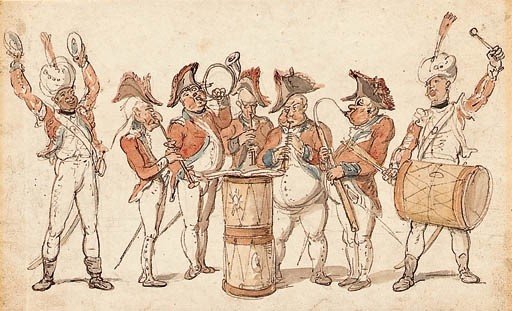
An even more striking example Janissary fashion is exhibited in the portrait of John
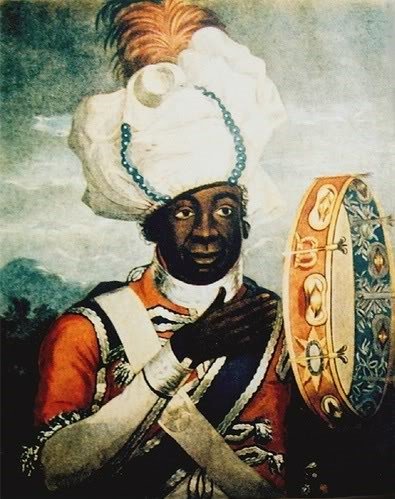 Fraser, a percussionist in the Coldstream Guards. He wears a large turban with feathers sticking out of it. His red coat features silver lace and tassels. His sleeves are red in the upper arm but turns into a white fabric. His instrument, the tambourine, is a direct import from Janissary music. Bands of music were integral to the martial music of the British Army. Stemming from the Harmoniemusik movement of the 18th century, regiments adapted the instrumentation to fit their needs. The talented soldier/musicians of these bands played everything from military marches to operatic symphonies. To set them apart from soldiers and drummers, their uniforms reflected the tastes of their officers as well popular movements in late 18th century pop culture.
Fraser, a percussionist in the Coldstream Guards. He wears a large turban with feathers sticking out of it. His red coat features silver lace and tassels. His sleeves are red in the upper arm but turns into a white fabric. His instrument, the tambourine, is a direct import from Janissary music. Bands of music were integral to the martial music of the British Army. Stemming from the Harmoniemusik movement of the 18th century, regiments adapted the instrumentation to fit their needs. The talented soldier/musicians of these bands played everything from military marches to operatic symphonies. To set them apart from soldiers and drummers, their uniforms reflected the tastes of their officers as well popular movements in late 18th century pop culture.
When the 23rd Regiment was inspected on May 27, 1768, Major General Oughton said:
"The band of Musick very fine. The whole perfectly well cloathed and appointed."[17]
After John Rowe attended the concert of Fife Major McLean in Boston, he wrote in his diary that;
"there was a large genteel Company & the best Musick I have heard performed there."
These bands were designed to impress their officers and audiences from the songs and instruments they played down to the lace on their coats.[18]
Footnotes: [13] Edinburgh Advertiser, 9 October 1772. Courtesy of Don Hagist[14] Don Hagist, "Notes on Bands of Music in the British Regiments," Originally published in The Brigade Dispatch, Volume XXVII, No. 1 (Spring 1997), pp. 17-19.[15] Pennsylvania Gazette, December 12, 1771. Courtesy of Don Hagist[16] For further reading on Turkish influence on European society, see Edmund A. Bowles, "The Impact of Turkish Military Bands on European Court Festivals in the 17th and 18th Centuries, " Early Music 34, no. 4 (2006): 533-59, http://www.jstor.org/stable/4137306. Raoul F. Camus, Military music of the American Revolution, Chapel Hill: University of North Carolina Press, 1977[17] Sherri Rapp, British Regimental Bands of Musick: The Material Culture of Regimental Bands of Music According to Pictorial Documentation, Extant Clothing, and Written Descriptions 1750-1800, Accessed September 4, 2017, https://www.scribd.com/presentation/215381883/British-Bands-of-Musick[18] John Rowe, Anne Rowe Cunningham, and Edward Lillie Pierce, Letters and Diary of John Rowe: Boston Merchant, 1759-1762, 1764-1779, Boston, MA: W.B. Clarke Co., 1903, Page 185, Accessed September 3, 2017. https://archive.org/details/lettersdiaryofjo00rowe
 JOSHUA MASONJoshua is an undergraduate student at Rhode Island College majoring in Secondary Education and History. He’s been researching fifers, drummers, and bands of music during the eighteenth century for the past 5 years.
JOSHUA MASONJoshua is an undergraduate student at Rhode Island College majoring in Secondary Education and History. He’s been researching fifers, drummers, and bands of music during the eighteenth century for the past 5 years.
Read Part 1 and Part 2! This is the final part in a 3 part post.
Bands of Music in the British Army 1762-1790
"The band of Musick very fine. The whole perfectly well cloathed and appointed"
On the 9th of March, 1768, Alexander Mackrabie wrote to his sister to describe his time in Philadelphia. Unfortunately for him, he writes, "at this place and at this season there is so little of anything amusing." In order to pass the time, Mr. Mackrabie described a recent practice in the city that was "extremely in vogue" called "Serenading."
We---with four or five young officers of the regiment in barracks---drink as hard as we can to keep out the cold, and about midnight sally forth, attended by the Band which consists of ten musicians, horns, clarionets, hautboys, and bassoons, march through the streets and play under the window of any lady you choose to distinguish, which they esteem a high Compliment. . . . I have been out twice and only once got a violent cold by it.[1]
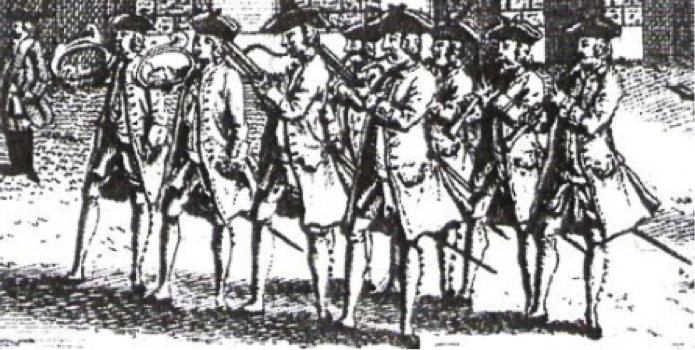
Bands of Music, also known simply as bands, were another musical entity that existed in the British Army. It is at this point that a distinction must be made between drums and fifes and bands of music. Drummers and fifers were enlisted to play the drum and fife for various duties in camp, signals in battle, and other martial ceremonies. In a regiment of foot, only the grenadier company was allowed two fifers. The other companies were only officially allowed one drummer per company, with the light company typically swapping its drummer for a horn player.[2]
Instrumentation of a band varied by regiment but generally followed the German tradition of Harmoniemusik, or wind music. Typically scored for at least 6 instruments, compositions included parts for clarinets, hautboys (known today as oboes), horns, and bassoons.[3]
A roll for the musicians of the 23rd Regiment exists from 1786. The leader, or Band Master was Jacob LeCroix. Under him were 2 clarinets, 2 hautboys, 2 bassoons, 2 horns, and a timpani player. All of the men under LeCroix served in America, with the newest member of the band having served 5 years by 1786.[4]
When the band of the Royal Artillery was formed in 1762, Lieutenant-Colonel Phillips came up with Articles of Agreement. They laid out rules that most other regiments would unofficially use for their own bands.
- The band to consist of eight men. who must also be capable to play upon the violoncello, bass, violin and flute, as other common instruments.
- The regiment's musick must consist of two trumpets, two French horns, two bassoons, and four hautbois or clarinets ; these instruments to be provided by the regiment, but kept in repair by the head musician.
- The musicians will be looked upon as actual soldiers, and cannot leave the regiment without a formal discharge. The same must also behave them, according to the articles of war.
- The aforesaid musicians will be clothed by the regiment.
- [In the handwriting of Colonel Phillips.] Provided the musicians are not found to be good performers at their arrival they will be discharged, and at their own expense. This is meant to make the person who engages the musicians careful in his choice.”[5]
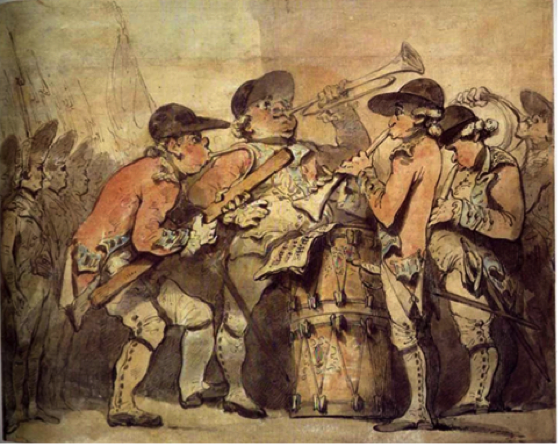
As seen in the Royal Artillery Articles of Agreement, bands were typically made up of private soldiers. These men would receive extra pay from the officers of a regiment to supplement their wages as well as buying instruments. The soldiers were not drummers and fifers; instead, they were known as musicians. Despite being soldiers, these men were talented professional musicians, often able to play multiple instruments. Members of the band did not play or typically fight in battle but instead fulfilled other duties, military and non-military.[6]
It was not uncommon for drummers or fifers to also be members of the band. William Simpson of the 29th Regiment deserted from New York in December of 1770. In his description, his officer wrote that Simpson
"plays well on the Flute and Fife, and plays a little on the Violin and French Horn. Had on when he went away, a short yellow Coat, fac'd Red,. . . the Coat lac'd with Drummers' Lace."
William Simpson was most likely a fifer in the 29th but because he could play multiple instruments, it is possible he was in the band. [7]
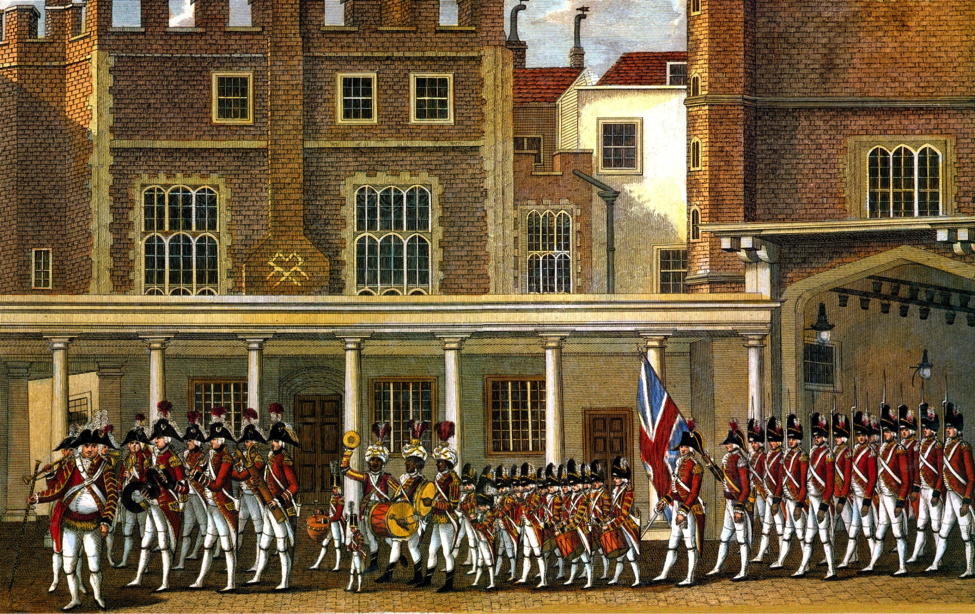
Now that we know what a band was and who their musicians were, the next post will cover the duties and repertoires of these "genteel corps of music."
Footnotes: [1] Philip France, Beata Francis, Eliza Keary, C. F. Keary, and Junius, The Francis Letters, New York: E.P. Dutton and Co., 1901, Pages 89-92, Accessed September 3, 2017, https://archive.org/details/cu31924088024413.[2] John Williamson, The Elements of Military Arrangement; Comprehending the Tacktick, Exercise, Manoevers, and Discipline of the British Infantry, with an Appendix, containing the substance of the principal standing Orders and Regulations for the Army, London: John Wiliamson, 1781, Page 7. Courtesy of Andrew Kirk[3] https://www.lipscomb.edu/windbandhistory/rhodeswindband_04_classical.htm[4] Sherri Rapp, British Regimental Bands of Musick: The Material Culture of Regimental Bands of Music According to Pictorial Documentation, Extant Clothing, and Written Descriptions 1750-1800, Accessed September 4, 2017, https://www.scribd.com/presentation/215381883/British-Bands-of-Musick[5] Ibid.[6] Williamson, The Elements, London: John Wiliamson, 1781, Page 7[7] The New-York Gazette or the Weekly Post-Boy, September 17, 1770, Page 4
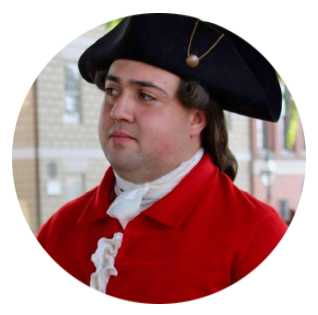 JOSHUA MASONJoshua is an undergraduate student at Rhode Island College majoring in Secondary Education and History. He's been researching fifers, drummers, and bands of music during the eighteenth century for the past 5 years.
JOSHUA MASONJoshua is an undergraduate student at Rhode Island College majoring in Secondary Education and History. He's been researching fifers, drummers, and bands of music during the eighteenth century for the past 5 years.

